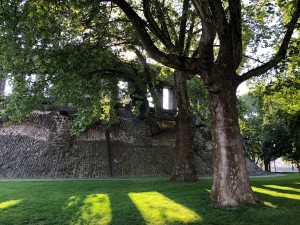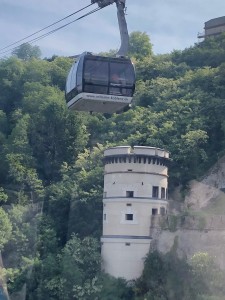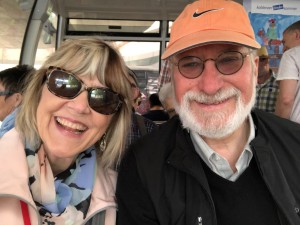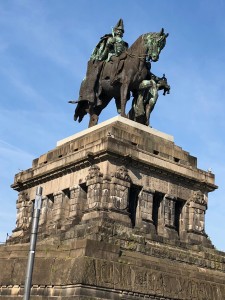 On the morning of Day 4 of our cruise we took a walking tour of Koblenz, Germany, a 2000-year-old trading settlement situated where the Rhine and Moselle Rivers meet. In fact, there’s a small peninsula jutting out into the confluence of these rivers with a public park called Deutsches Eck, the city’s famed German Corner. The park features a large equestrian statue of Emperor Wilheim I.
On the morning of Day 4 of our cruise we took a walking tour of Koblenz, Germany, a 2000-year-old trading settlement situated where the Rhine and Moselle Rivers meet. In fact, there’s a small peninsula jutting out into the confluence of these rivers with a public park called Deutsches Eck, the city’s famed German Corner. The park features a large equestrian statue of Emperor Wilheim I.
From there we took a cable car ride up to Braubach, where the 13th-century Marksburg Castle watches over the town. We didn’t take the tour of the castle, but it was fun to see the medieval fair that was taking place on the grounds on this beautiful Saturday morning.
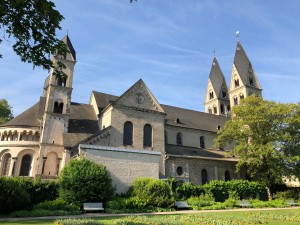 Back down in Koblenz, we toured the Old Town and the baroque City Hall, with so many influences from ancient Rome, the Middle Ages, and the Napoleonic era. In touching distance of the Deutsches Eck are the pointed Romanesque towers of the oldest church in Koblenz. Once attached to a monastery, the Basilica of St. Castor is part of that UNESCO World Heritage Site for the epochal events that have taken place since its foundation 1,200 years ago. It was at this place in 842 that 110 representatives negotiated the division of the Frankish Empire. Most of the architecture is from the 12th century and although the church did take damage in the Second World War, this was reparable.
Back down in Koblenz, we toured the Old Town and the baroque City Hall, with so many influences from ancient Rome, the Middle Ages, and the Napoleonic era. In touching distance of the Deutsches Eck are the pointed Romanesque towers of the oldest church in Koblenz. Once attached to a monastery, the Basilica of St. Castor is part of that UNESCO World Heritage Site for the epochal events that have taken place since its foundation 1,200 years ago. It was at this place in 842 that 110 representatives negotiated the division of the Frankish Empire. Most of the architecture is from the 12th century and although the church did take damage in the Second World War, this was reparable.
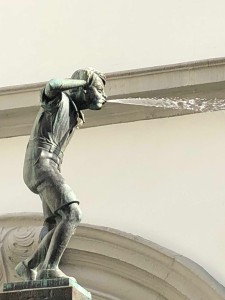
The citizens of Koblenz are especially fond of their children. We loved this statue of “The Spitting Boy,” which playfully spits water out at admirers every two minutes.
 They also love ducks, like this one we passed on our walk. And this statue of a little girl with ducks in Old Town.
They also love ducks, like this one we passed on our walk. And this statue of a little girl with ducks in Old Town.
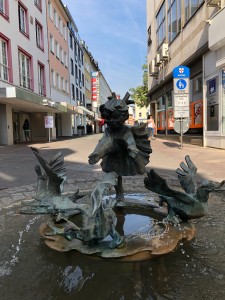 What a lovely way to spend a morning. Back on the ship we cruised the Middle Rhine all afternoon—the most scenic part of the cruise with a multitude of castles, so stay tuned for my next post! Meanwhile, enjoy a few more pictures from Koblenz!
What a lovely way to spend a morning. Back on the ship we cruised the Middle Rhine all afternoon—the most scenic part of the cruise with a multitude of castles, so stay tuned for my next post! Meanwhile, enjoy a few more pictures from Koblenz!
